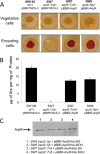Sigma factor RpoS controls alkylresorcinol synthesis through ArpR, a LysR-type regulatory protein, during encystment of Azotobacter vinelandii
- PMID: 23378510
- PMCID: PMC3624571
- DOI: 10.1128/JB.01946-12
Sigma factor RpoS controls alkylresorcinol synthesis through ArpR, a LysR-type regulatory protein, during encystment of Azotobacter vinelandii
Abstract
Azotobacter vinelandii is a bacterium which undergoes a differentiation process leading to the formation of metabolically dormant cysts. During the encystment process, A. vinelandii produces alkylresorcinol lipids (ARs) that replace the membrane phospholipids and are also components of the layers covering the cyst. The synthesis of ARs in A. vinelandii has been shown to occur by the activity of enzymes encoded by the arsABCD operon, which is expressed only during the differentiation process. Also, the production of ARs has been shown to be dependent on the stationary-phase sigma factor RpoS, which is also implicated in the control of the synthesis of other cyst components (i.e., alginate and poly-β-hydroxybutyrate). In this study, we identified ArpR, a LysR-type transcriptional regulator expressed only during encystment that positively regulates arsABCD transcription. We show that this activation is dependent on acetoacetyl-coenzyme A (acetoacetyl-CoA), which might provide a metabolic signal for encystment. We also show that RpoS regulates arsABCD expression through the control of arpR transcription.
Figures









Similar articles
-
The GacS/A-RsmA Signal Transduction Pathway Controls the Synthesis of Alkylresorcinol Lipids that Replace Membrane Phospholipids during Encystment of Azotobacter vinelandii SW136.PLoS One. 2016 Apr 7;11(4):e0153266. doi: 10.1371/journal.pone.0153266. eCollection 2016. PLoS One. 2016. PMID: 27055016 Free PMC article.
-
Roles of RpoS and PsrA in cyst formation and alkylresorcinol synthesis in Azotobacter vinelandii.Microbiology (Reading). 2011 Jun;157(Pt 6):1685-1693. doi: 10.1099/mic.0.046268-0. Epub 2011 Mar 31. Microbiology (Reading). 2011. PMID: 21454367
-
The unphosphorylated EIIA(Ntr) protein represses the synthesis of alkylresorcinols in Azotobacter vinelandii.PLoS One. 2015 Feb 2;10(2):e0117184. doi: 10.1371/journal.pone.0117184. eCollection 2015. PLoS One. 2015. PMID: 25642700 Free PMC article.
-
Regulation of nitrogen fixation in Klebsiella pneumoniae and Azotobacter vinelandii: NifL, transducing two environmental signals to the nif transcriptional activator NifA.J Mol Microbiol Biotechnol. 2002 May;4(3):235-42. J Mol Microbiol Biotechnol. 2002. PMID: 11931553 Review.
-
Regulation in the rpoS regulon of Escherichia coli.Can J Microbiol. 1998 Aug;44(8):707-17. doi: 10.1139/cjm-44-8-707. Can J Microbiol. 1998. PMID: 9830102 Review.
Cited by
-
RpoS controls the expression and the transport of the AlgE1-7 epimerases in Azotobacter vinelandii.FEMS Microbiol Lett. 2018 Oct 1;365(19):fny210. doi: 10.1093/femsle/fny210. FEMS Microbiol Lett. 2018. PMID: 30169849 Free PMC article.
-
LEA proteins are involved in cyst desiccation resistance and other abiotic stresses in Azotobacter vinelandii.Cell Stress Chaperones. 2017 May;22(3):397-408. doi: 10.1007/s12192-017-0781-1. Epub 2017 Mar 3. Cell Stress Chaperones. 2017. PMID: 28258486 Free PMC article.
-
Phylogenomics, phenotypic, and functional traits of five novel (Earth-derived) bacterial species isolated from the International Space Station and their prevalence in metagenomes.Sci Rep. 2023 Nov 6;13(1):19207. doi: 10.1038/s41598-023-44172-w. Sci Rep. 2023. PMID: 37932283 Free PMC article.
-
Phylogenetic affiliations and genomic characterization of novel bacterial species and their abundance in the International Space Station.Res Sq [Preprint]. 2023 Jul 6:rs.3.rs-3126314. doi: 10.21203/rs.3.rs-3126314/v1. Res Sq. 2023. PMID: 37461605 Free PMC article. Preprint.
-
Transcriptional Study of the RsmZ-sRNAs and Their Relationship to the Biosynthesis of Alginate and Alkylresorcinols in Azotobacter vinelandii.Mol Biotechnol. 2018 Sep;60(9):670-680. doi: 10.1007/s12033-018-0102-7. Mol Biotechnol. 2018. PMID: 29987520
References
-
- Reusch RN, Sadoff HL. 1983. Novel lipid components of the Azotobacter vinelandii cyst membrane. Nature 302:268–270 - PubMed
Publication types
MeSH terms
Substances
LinkOut - more resources
Full Text Sources
Other Literature Sources
Molecular Biology Databases

